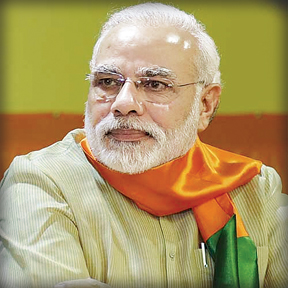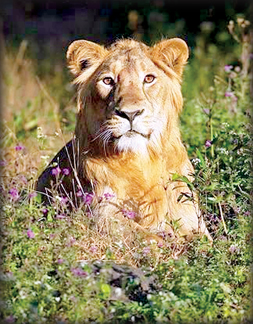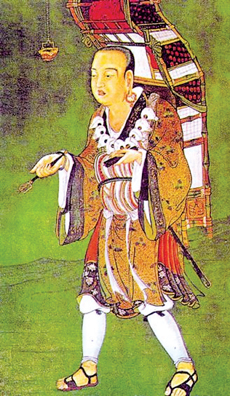|

Narendera Modi, the Lion of Gujarat |
Modi’s dream
A ‘big’ Buddhist temple in Gujarat:
by Special Correspondent
One of Indian Prime Minister Narendra Modi’s unfulfilled dreams has
been to build a “big” Buddhist temple cum research centre in his native
state of Gujarat.
He had given expression to this wish in an international seminar on
Buddhism at the Maharajah Sayaji Rao University in Baroda in 2010, when
he was Chief Minister of Gujarat.
Interestingly, Modi’s concept of the temple is not just a place of
worship but a centre for higher learning and research on the “science of
the mind” from the point of view of the world’s different religions and
schools of secular thought.
He wants it to be a place where scholars from all religions, of the
West and the East, and secular experts from the West and East, will
interact.
Modi believes that Buddhism could be the cornerstone of the modern
world. He quotes Arnold Toynbee as saying that the most important event
in the 20th.Century is not the landing of man on the moon, or sending a
probe to Mars, but the coming of Buddhism to the West.
“I believe that one need not read voluminous philosophical treatises
on Buddhism to understand the Buddha. He had much to offer in the four
simple truths than the wisdom contained in all the libraries of the
world,” Modi declared at the seminar.
|

The Vadnagar resting place for Bhikkhus |
“Personally, I used to marvel at the concept of the Bodhisattva. I
think that should be the aim of not only monks and saints but also of
those who are in public life. One should put oneself the last.
Compassion is the basic necessity not only in spiritual Sadhana but in
political life as well.
In the troubled times we live, Buddhist teachings must be assimilated
in our ethos, in our children, for a peaceful and healthy future, for it
reflects the ethos of Indian culture and tradition,” he said.
Modi does not view the doctrine of Karma as a fatalistic one,
something anti-modern.
“The Buddha did not speak about Karma as an ever-binding entity but
as a chain which can be cut and removed with proper tools,” he said.
Modi could not pursue his dream of building this massive temple cum
centre of philosophic excellence because he unexpectedly plunged into
national politics to become Prime Minister of India in 2014. However,
even as he was caught up in the tough business of running a complex
country like India, Modi did not lose sight of Buddhism.
When he visited Japan as Prime Minister, he spent considerable time
at the Toji and Kinkakuji Buddhist temples. When he went to Nepal, he
wanted to visit Lumbini, the birthplace of the Buddha, but could not
make it because of pressing engagements back in India.
Not surprisingly, when he planned his visit to Sri Lanka, he asked to
be taken to Anuradhapura, the home of the Bodhi tree which Emperor
Asoka’s daughter Sangamitta had brought to Sri Lanka in 245 BC.
|

The Gir forest in Gujarat is home to the Asiatic Lion |
Modi’s links with Buddhism owes much to the fact that his hometown,
Vadnagar in Mehsana District, had been a major Buddhist centre in
7th.Century AD. The Chinese Buddhist priest-traveller Hiuen Tsang, had
visited it in 641 AD and written about it. In Hiuen Tsang’s time,
Vadnagar was known as Anandapura.
Importance of Archaeology
According to Modi, till the early 19th century, people thought that
the Buddha was only a mythological figure. It was through a series of
excavations done by the British in Varanasi that it was established that
he was not a mythological figure but a historical figure and a human
being.
The places where he lived, the paths he walked were identified along
with the words he spoke to establish him as a historical figure. It is
through archaeological excavations that Gujarat’s historical links with
Buddhism have been established.
The widespread presence of Buddhism in Gujarat can be seen in
inscriptions on the Stupas, Chaityagrahas, Viharas, and Sculptures, in
that state. The Pali scripture Theragatha says that even during the time
of the Buddha, a few from Gujarat had become Buddhists.
Names such as Vaddha Thera and Malitavamba Thera of Bharuch occur in
Theragatha. Thus, the link between the Buddha and Gujarat is as old as
the Buddha himself, Modi avers.
Trade and commerce had also played a role in bringing Buddhism to
Western India. Gujarat (in Western India), particularly Bharukaccha
(modern day Bharoch), the ancient international port, is frequently
mentioned in the oldest Buddhist literature. This is because traders
from the then known Buddhist centres such as Benaras (Varanasi) and
Vaishali, brought Buddhism to Gujarat along with their merchandise.
Dr. Raj Somadeva of the Archaeology Department of Kelaniya University
in Sri Lanka, corroborated this when he said that Sri Lankan ships used
to go regularly to Bharukaccha. And so intense was the traffic, that
there was a whole community of Sri Lankan sailors called Bharukachcha
Navikawa.
Vadnagar
 It was in 2009, that excavations by the Gujarat Department of
Archaeology revealed the existence of a Buddhist monastery in Modi’s
hometown Vadnagar, although a statue of the Buddha in the sitting
posture, dating back to the second or third century AD, had been
accidentally discovered in a farm near Vadnagar in the late 1980s. It was in 2009, that excavations by the Gujarat Department of
Archaeology revealed the existence of a Buddhist monastery in Modi’s
hometown Vadnagar, although a statue of the Buddha in the sitting
posture, dating back to the second or third century AD, had been
accidentally discovered in a farm near Vadnagar in the late 1980s.
According to India Today, 24 seals had been discovered at the
monastery site till 2012, exciting the curiosity of renowned
archaeologists like Robin Cunningham of the University of Durham, and
Mark Kanyor of Wisconsin University.
“Stupas at the site reveal three different stages of an evolving
Buddhist architecture, from cylindrical and circular shapes to square
and molded plinths,” the magazine said. Two more monasteries have since
been discovered.
“The new revelations in Vadnagar prove that Gujarat was an important
Buddhist centre. Both the stupas and the monasteries correspond to three
periods of Buddhist development, spread from the first to the seventh
century AD,” the magazine quoted Y.S. Rawat, Head of the Gujarat
Government Department of Archaeology, as saying.
According to Modi, while Buddhism was accepted both by the common
folk and the upper castes in Gujarat, its main patrons were the
merchants who donated vast amounts of money for Buddhist activities.
Prosperous merchants supported Buddhist intellectual giants like
Dharmagupta, Shrimathi and Gunamathi, he said.
Asoka’s role
Buddhism took firm roots in Gujarat at the time of Emperor Asoka,
Modi points out.
|

Chinese priest cum traveller Hiuen Tsang |
“The Asokan rock edict in Jungadh bears witness to the spread of
Buddhism in Gujarat during Asoka’s time. Researchers should find out if
the Lion Pillar with four lions put up by Asoka at Sarnath was inspired
by Gujarat as Gujarat is the only place where lions exist in the Asian
region,” Modi said. The Lion Pillar is the official symbol of India
since 1950.
The Greeks, Partho-Scythians, Satvahanas, the Bodhi dynasty,
Ksatrapas and the Saka rulers supported Buddhism. During their rule,
several rock-cut monuments appeared in Gujarat. During the time of the
Maitraka kings there were more than 13,000 monks in Gujarat. The
Vallabhi Buddhist University in Vallabhipur in Gujarat was one of the
principal seats of learning those days, Modi recalls with pride.
“Gujarat is also the land of Shantideva, who gave the marvellous
Bodhcaryavatara - one of the landmark texts in Buddhism in Sanskrit -
which is known to us as ‘the way of the Bodhisattva’. Hundreds of
commentaries have been written on his text, but the infinite wisdom in
his words remains to be explored in full,” he points out.
On pilgrim’s route
Modi is keen on making Gujarat part of the world Buddhist pilgrimage
circuit.
“So far, the Buddhist aspect of Gujarat has not been given due
attention. I feel that the time has come to make it known to millions of
Buddhists, scholars and lovers of Buddhism all over the globe,” he
suggests. The Buddhist circuit in India till date, has included only
Bodh Gaya and Sarnath. Sanchi is recognised by some. But all these
places are outside Gujarat. |

